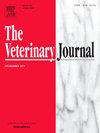Feasibility and cartilage injury of an all-inside arthroscopic meniscal repair application in a canine cadaveric study
IF 3.1
2区 农林科学
Q1 VETERINARY SCIENCES
引用次数: 0
Abstract
Meniscal injury is the most common comorbidity in canine stifles with cranial cruciate ligament (CCL) pathology. Arthroscopic repair for acute tears can be technically challenging and is rarely described. This study evaluates the feasibility of using an all-inside arthroscopic meniscal repair device, Arthrex Meniscal Cinch II™ (MCII) in canine cadaveric stifles and the associated risks of iatrogenic vascular injury (IVI) and cartilage injury (ICI). 20 healthy paired canine cadaveric stifles (25 – 45 kg BW) were divided randomly into two groups of 10. Both groups received transection of the CCL via mini arthrotomy, joint distraction and diagnostic arthroscopy with meniscal probing. No further procedures were performed in the control group whereas the implant group underwent placement of the MCII-implants in the caudal horn of the medial meniscus. Angiography of the femoral artery was performed for each limb before and after operation and vascular trauma was assessed on radiographs. After disarticulation, the cartilage was stained via Indian ink assay and underwent blinded scoring for ICI. Implants were evaluated for desired position. Correct position of the MCII-implants was achieved in all stifles. No IVI was detected. Implant placement created more ICI on the medial femoral condyle (1.33 mm2) than arthroscopy alone (0.15 mm2) (p = 0.03). Implant associated complications occurred in 30 %. Arthroscopic use of MCII is feasible and carries minimal risk for vascular damage. Despite joint distraction, implant placement using the MCII is associated with significant cartilage damage. Although technically challenging, all-inside meniscal repair appears to carry limited risk in canine patients over 25 kg bodyweight.
全内关节镜半月板修复术在犬尸体研究中的可行性及软骨损伤
半月板损伤是最常见的合并症在犬窒息与颅交叉韧带(CCL)病理。关节镜下修复急性撕裂在技术上具有挑战性,很少被描述。本研究评估了全内关节镜下半月板修复装置Arthrex meniscal Cinch II™(MCII)在犬尸体僵硬中的可行性,以及医源性血管损伤(IVI)和软骨损伤(ICI)的相关风险。选取25 ~ 45 kg BW的健康狗尸20只,随机分为两组,每组10只。两组均通过小关节切开术、关节撑开术和半月板探查诊断性关节镜切除CCL。对照组没有进一步的手术,而植入组在内侧半月板尾角植入了mcii植入物。术前、术后均行股动脉造影,并通过x线片评估血管损伤。脱关节后,通过墨迹染色法对软骨进行染色,并对ICI进行盲法评分。评估种植体的理想位置。所有病例均实现了mci -implant的正确位置。未检测到IVI。植入假体在股骨内侧髁上产生的ICI(1.33 mm2)比单纯关节镜检查(0.15 mm2)更多(p = 0.03)。种植体相关并发症发生率为30% %。关节镜下使用MCII是可行的,并且血管损伤的风险最小。尽管关节牵张,使用MCII植入物仍与明显的软骨损伤相关。尽管在技术上具有挑战性,但对于体重超过25 kg的犬类患者,全内半月板修复似乎风险有限。
本文章由计算机程序翻译,如有差异,请以英文原文为准。
求助全文
约1分钟内获得全文
求助全文
来源期刊

Veterinary journal
农林科学-兽医学
CiteScore
4.10
自引率
4.50%
发文量
79
审稿时长
40 days
期刊介绍:
The Veterinary Journal (established 1875) publishes worldwide contributions on all aspects of veterinary science and its related subjects. It provides regular book reviews and a short communications section. The journal regularly commissions topical reviews and commentaries on features of major importance. Research areas include infectious diseases, applied biochemistry, parasitology, endocrinology, microbiology, immunology, pathology, pharmacology, physiology, molecular biology, immunogenetics, surgery, ophthalmology, dermatology and oncology.
 求助内容:
求助内容: 应助结果提醒方式:
应助结果提醒方式:


